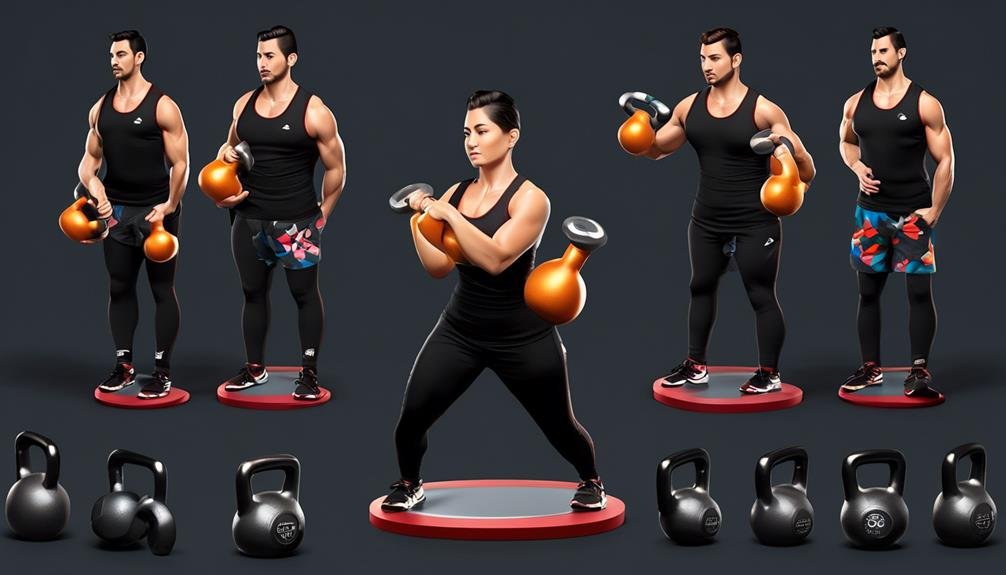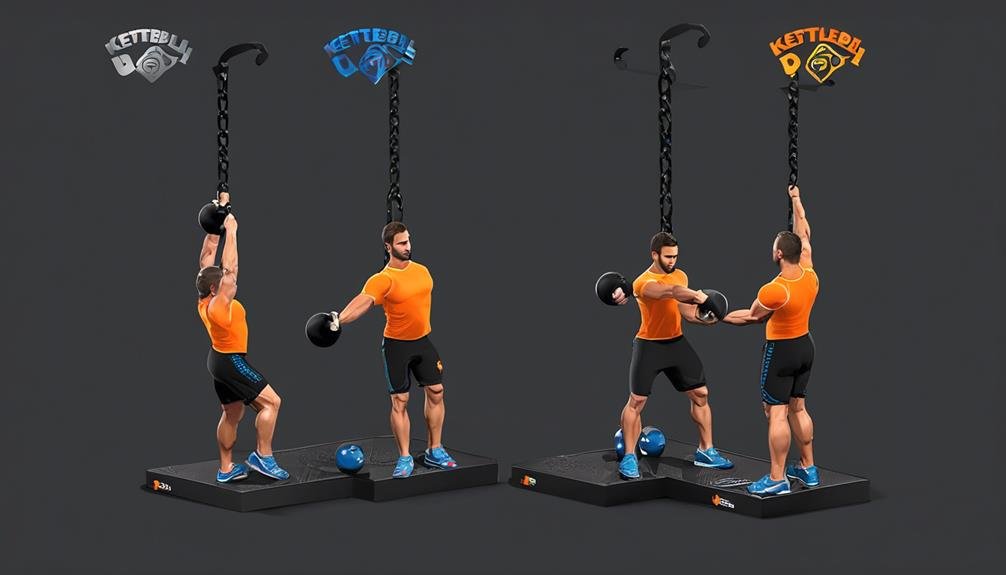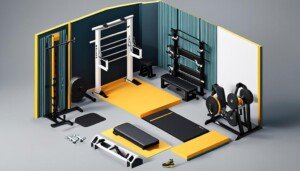Imagine yourself standing in front of a row of gleaming kettlebells, each one beckoning you to pick it up and unleash your strength. But how do you determine the right weight to lift? It's a question that many fitness enthusiasts grapple with, and one that requires careful consideration.
In this discussion, we will explore the factors that come into play when choosing the appropriate weight for kettlebell exercises.
So, let's dive in and discover the secrets to selecting the perfect kettlebell weight for your workout routine.
Key Takeaways
- Assess your strength level by determining the maximum weight you can comfortably lift for each exercise.
- Evaluate your endurance level by determining how many repetitions of an exercise you can perform with proper technique before fatigue sets in.
- Choose a weight that challenges you without compromising form or risking injury.
- Gradually increase the weight as your strength and technique improve, while listening to your body and adjusting as needed.
Understanding Your Fitness Level
To accurately determine the right weight for kettlebell exercises, it's crucial to have a clear understanding of your fitness level. This understanding will help you choose a weight that challenges you without causing injury or hindering your progress. Your fitness level can be assessed by considering factors such as your strength, endurance, and overall physical condition.
Start by assessing your strength level. Determine the maximum weight you can comfortably lift for each exercise. This will give you a baseline to work from and help you choose a weight that pushes you slightly beyond your current capabilities. It's important to challenge yourself, but avoid selecting a weight that's too heavy and compromises your form.
Next, evaluate your endurance level. Determine how many repetitions of an exercise you can perform with proper technique before fatigue sets in. This will guide you in selecting a weight that allows you to complete a set without sacrificing form or risking injury.
Consider your overall physical condition. Take into account any existing injuries or limitations that may affect your ability to handle certain weights. It's essential to listen to your body and make adjustments accordingly.
Assessing Your Strength and Endurance
Now let's focus on evaluating your strength and endurance to determine the right weight for your kettlebell exercises. Assessing your strength and endurance is crucial in order to select the appropriate kettlebell weight that will challenge you without causing injury or strain.
To start, consider your current fitness level. If you're new to kettlebell exercises or have been inactive for a while, it's recommended to start with a lighter weight to allow your body to adapt gradually. This will help prevent muscle soreness and reduce the risk of injury.
Next, assess your strength by performing a few basic movements, such as squats, lunges, and overhead presses, with different kettlebell weights. Pay attention to how challenging each weight feels and whether you can maintain proper form throughout the exercises. If you feel like you're struggling to complete the movements or your form starts to suffer, it may be an indication that the weight is too heavy for your current strength level.
Similarly, evaluate your endurance by performing a set of exercises for a specific duration, such as kettlebell swings or snatches, with different weights. Take note of how long you can sustain the exercise with each weight and whether you can maintain a consistent pace. If you find it difficult to complete the set or your pace significantly slows down, it may be a sign that the weight is too heavy for your endurance level.
Considering the Specific Exercise

Consider the specific exercise to determine the appropriate weight for your kettlebell. Different kettlebell exercises target different muscle groups and require varying levels of strength and stability. By selecting the right weight for each exercise, you can maximize your results and minimize the risk of injury.
To help you choose the proper weight, refer to the table below. It provides a general guideline for selecting kettlebell weights based on your fitness level and the specific exercise you plan to perform:
| Exercise | Beginner | Intermediate | Advanced | Expert |
|---|---|---|---|---|
| Swing | 8-12 kg | 12-16 kg | 16-20 kg | 20+ kg |
| Goblet Squat | 6-10 kg | 10-14 kg | 14-18 kg | 18+ kg |
| Turkish Get-Up | 8-12 kg | 12-16 kg | 16-20 kg | 20+ kg |
| Clean and Press | 8-12 kg | 12-16 kg | 16-20 kg | 20+ kg |
| Snatch | 8-12 kg | 12-16 kg | 16-20 kg | 20+ kg |
Listening to Your Body
Pay attention to your body's signals to determine the appropriate weight for your kettlebell exercises. Your body knows best, so it's important to listen to what it's telling you. Here are three key points to consider when listening to your body during your kettlebell workout:
- Comfort and Control: Start with a weight that allows you to perform the exercises comfortably and with proper form. If you're struggling to maintain control or experiencing pain or discomfort, it may be a sign that the weight is too heavy. Gradually increase the weight as your strength and technique improve.
- Fatigue and Recovery: Pay attention to how your body feels during and after each set. If you're unable to complete the desired number of repetitions or feeling excessively fatigued during your workout, it could indicate that the weight is too heavy. On the other hand, if you find the exercises too easy or aren't experiencing any muscle fatigue, it may be time to increase the weight.
- Progression and Adaptation: As you continue with your kettlebell training, your body will adapt and become stronger. It's important to periodically reassess your weight selection to ensure continued progress. Gradually increase the weight as your strength improves, challenging your muscles to grow and adapt to the increased load.
Gradually Progressing in Weight

When progressing in weight for your kettlebell exercises, gradually increase the load to challenge your muscles and promote continuous growth and strength adaptation. Gradually progressing in weight is crucial to prevent injury and ensure effective results from your kettlebell workouts.
To begin, start with a weight that feels comfortable and allows you to perform the exercises with proper form and technique. As you become more proficient and your muscles adapt to the workload, you can gradually increase the weight. This progression should be done in small increments, typically 2-4 kilograms (4-8 pounds) at a time.
Listen to your body throughout the process. If you find that the weight is too heavy and compromises your form, reduce the load until you can perform the exercises correctly. It's better to use a lighter weight and maintain proper technique than to risk injury by using a weight that's too heavy.
Remember that progress takes time. Aim to increase the weight once you can comfortably complete your current routine with the current weight. This gradual progression will challenge your muscles and stimulate growth, helping you achieve your fitness goals safely and effectively.
Frequently Asked Questions
Can I Use a Heavier Kettlebell if I Have Previous Weightlifting Experience?
If you have previous weightlifting experience, you can consider using a heavier kettlebell. However, it's important to listen to your body and gradually increase the weight to avoid injury.
Is There an Ideal Weight Range for Kettlebell Exercises That Target Specific Muscle Groups?
When determining the right weight for kettlebell exercises, it's important to consider the specific muscle groups you want to target. There is an ideal weight range for each muscle group, which can be determined through trial and error.
How Often Should I Reassess My Strength and Endurance to Determine if I Need to Increase the Weight of My Kettlebell?
You should reassess your strength and endurance regularly to determine if you need to increase the weight of your kettlebell. This will help you challenge yourself and continue making progress in your workouts.
Can I Use Different Weights for Different Exercises Within the Same Workout?
Yes, you can use different weights for different exercises within the same workout. It's important to select a weight that challenges you but allows for proper form and technique. Adjust as needed for each exercise.
Are There Any Safety Precautions I Should Take When Choosing a Kettlebell Weight?
To ensure safety when selecting a kettlebell weight, consider your fitness level, exercise experience, and any previous injuries. Start with a lighter weight and gradually increase as you build strength and confidence.
Conclusion
Determining the right weight for kettlebell exercises requires assessing your fitness level, strength, endurance, and the specific exercise you're performing.
It's important to listen to your body and gradually progress in weight to avoid injury.
By considering these factors and gradually increasing the weight, you can ensure a safe and effective kettlebell workout that suits your individual needs and goals.
Remember, always prioritize safety and consult a professional if you're unsure.





